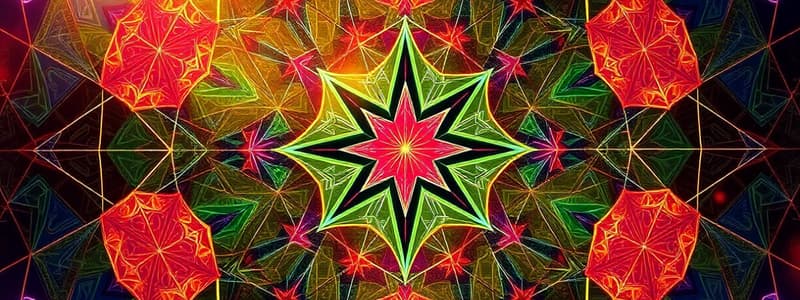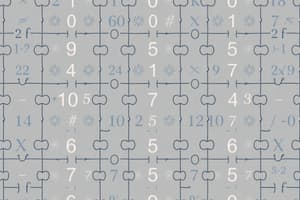Podcast
Questions and Answers
What sequence does the number of little squares in the Stacked Squares shape follow?
What sequence does the number of little squares in the Stacked Squares shape follow?
- Triangular numbers
- Fibonacci sequence
- Square numbers (correct)
- Counting numbers
How can the number of little triangles in each shape of the Stacked Triangles be described?
How can the number of little triangles in each shape of the Stacked Triangles be described?
- It forms a geometric sequence.
- It matches the prime number sequence.
- It forms a triangular number sequence. (correct)
- It forms a linear sequence.
What pattern characterizes the Koch Snowflake sequence in terms of line segments?
What pattern characterizes the Koch Snowflake sequence in terms of line segments?
- 3 times powers of 4 (correct)
- Even numbers
- Powers of 2
- Fibonacci numbers
Which of the following is NOT a basic pattern occurring in mathematics?
Which of the following is NOT a basic pattern occurring in mathematics?
How does one get from one shape to the next in the Koch Snowflake?
How does one get from one shape to the next in the Koch Snowflake?
Which of these does NOT describe an important number sequence?
Which of these does NOT describe an important number sequence?
What can be considered as a fundamental goal of mathematics?
What can be considered as a fundamental goal of mathematics?
In sequences like the Koch Snowflake, what happens to the line segments as the process is repeated?
In sequences like the Koch Snowflake, what happens to the line segments as the process is repeated?
What defines a regular polygon?
What defines a regular polygon?
Starting from 3, which sequence represents the number of sides in regular polygons?
Starting from 3, which sequence represents the number of sides in regular polygons?
How are the number of sides and corners related in regular polygons?
How are the number of sides and corners related in regular polygons?
What shape corresponds to the number of sides 8 in regular polygons?
What shape corresponds to the number of sides 8 in regular polygons?
What general pattern can be observed in the sequence of regular polygons?
What general pattern can be observed in the sequence of regular polygons?
In the sequence of complete graphs, what can be concluded about the number of lines?
In the sequence of complete graphs, what can be concluded about the number of lines?
Which regular polygon is defined as a shape with 5 sides?
Which regular polygon is defined as a shape with 5 sides?
Why is understanding shape sequences helpful in studying number sequences?
Why is understanding shape sequences helpful in studying number sequences?
What branch of mathematics focuses on the study of patterns in whole numbers?
What branch of mathematics focuses on the study of patterns in whole numbers?
Which sequence represents the pattern of odd numbers?
Which sequence represents the pattern of odd numbers?
Which of the following number sequences is known as triangular numbers?
Which of the following number sequences is known as triangular numbers?
What is the next number in the sequence of squares: 1, 4, 9, 16, 25?
What is the next number in the sequence of squares: 1, 4, 9, 16, 25?
How has mathematics most significantly contributed to modern transportation?
How has mathematics most significantly contributed to modern transportation?
Which of the following sequences represents counting numbers?
Which of the following sequences represents counting numbers?
What is the defining characteristic of even numbers?
What is the defining characteristic of even numbers?
Which sequence is known for representing cube numbers?
Which sequence is known for representing cube numbers?
What is the sum of the first five odd numbers?
What is the sum of the first five odd numbers?
What pattern is observed when adding consecutive odd numbers?
What pattern is observed when adding consecutive odd numbers?
What is the sum of the first 10 odd numbers?
What is the sum of the first 10 odd numbers?
How is the concept of odd numbers and square numbers demonstrated visually?
How is the concept of odd numbers and square numbers demonstrated visually?
What is the pattern observed in the sequence 1, 1+2, 1+2+3, ...?
What is the pattern observed in the sequence 1, 1+2, 1+2+3, ...?
If the pattern of odd numbers continues, what will be the sum of the first 100 odd numbers?
If the pattern of odd numbers continues, what will be the sum of the first 100 odd numbers?
In the pattern of summing up and down, what is the maximum number reached in the sequence 1 + 2 + 3 + 4 + 5 + 6 + 5 + 4 + 3 + 2 + 1?
In the pattern of summing up and down, what is the maximum number reached in the sequence 1 + 2 + 3 + 4 + 5 + 6 + 5 + 4 + 3 + 2 + 1?
What is the significance of square numbers in the context of odd number addition?
What is the significance of square numbers in the context of odd number addition?
What is the next number in the sequence 1, 2, 4, 8, 16, 32, 64?
What is the next number in the sequence 1, 2, 4, 8, 16, 32, 64?
Which sequence represents the powers of 3?
Which sequence represents the powers of 3?
What pattern do the triangular numbers follow?
What pattern do the triangular numbers follow?
Which of the following sequences represents the odd numbers?
Which of the following sequences represents the odd numbers?
What is the third number in the sequence of squares?
What is the third number in the sequence of squares?
How is the sequence of even numbers formed?
How is the sequence of even numbers formed?
Which of the following numbers is NOT a cube?
Which of the following numbers is NOT a cube?
Which of these numbers belongs in the sequence starting 1, 2, 4, 8, 16?
Which of these numbers belongs in the sequence starting 1, 2, 4, 8, 16?
What is the rule for forming the counting numbers sequence?
What is the rule for forming the counting numbers sequence?
What is the next number in the sequence of cubes 1, 8, 27, 64?
What is the next number in the sequence of cubes 1, 8, 27, 64?
Flashcards are hidden until you start studying
Study Notes
Patterns in Mathematics
- Mathematics often seeks patterns and explanations for their existence.
- Number sequences are fundamental patterns studied in mathematics.
- Examples of number sequences include counting numbers, odd numbers, even numbers, square numbers, triangular numbers, cubes, Virahānka numbers, and powers of 2.
Sequence of Regular Polygons
- Each shape in the sequence of regular polygons has an increasing number of sides starting from 3.
- Corresponding names of the shapes include regular triangle, quadrilateral, pentagon, hexagon, and so on.
- Regular shapes have equal-length sides and equal angles.
Rule Identification
- Identifying the number of sides or corners in regular polygons aligns with counting numbers.
- Number of lines in complete graphs represents a unique number sequence that can be analyzed.
- For stacked squares and triangles, counting the number of smaller shapes reveals patterns linked to number sequences.
The Koch Snowflake
- In the Koch snowflake sequence, a line segment is replaced by a more complex shape with each iteration.
- The total number of line segments evolves through a distinct sequence: 3, 12, 48, etc.
Visualizing Number Sequences
- Some number sequences can be pictorially represented to enhance understanding of their patterns.
- For instance, square numbers can be visualized as dots arranged in a square grid.
- Partitioning dots in a square grid can illustrate the relationship between square numbers and the sum of odd numbers.
Addition of Odd Numbers
- The pattern of adding consecutive odd numbers results in square numbers, e.g., 1 + 3 + 5 + 7 + 9 = 25.
- This pattern continues indefinitely, confirming the relationship between odd numbers and squares.
Summary of Number Sequences
- Patterns in whole numbers form the basis of number theory.
- Various important number sequences include:
- All 1's: 1, 1, 1...
- Counting numbers: 1, 2, 3...
- Odd numbers: 1, 3, 5...
- Even numbers: 2, 4, 6...
- Triangular numbers: 1, 3, 6...
- Square numbers: 1, 4, 9...
- Cube numbers: 1, 8, 27...
- Virahānka numbers: 1, 2, 3...
- Powers of 2: 1, 2, 4...
- Powers of 3: 1, 3, 9...
Everyday Applications of Mathematics
- Mathematics plays a crucial role in various aspects of life including science, economy, architecture, technology, and daily tools.
Studying That Suits You
Use AI to generate personalized quizzes and flashcards to suit your learning preferences.




